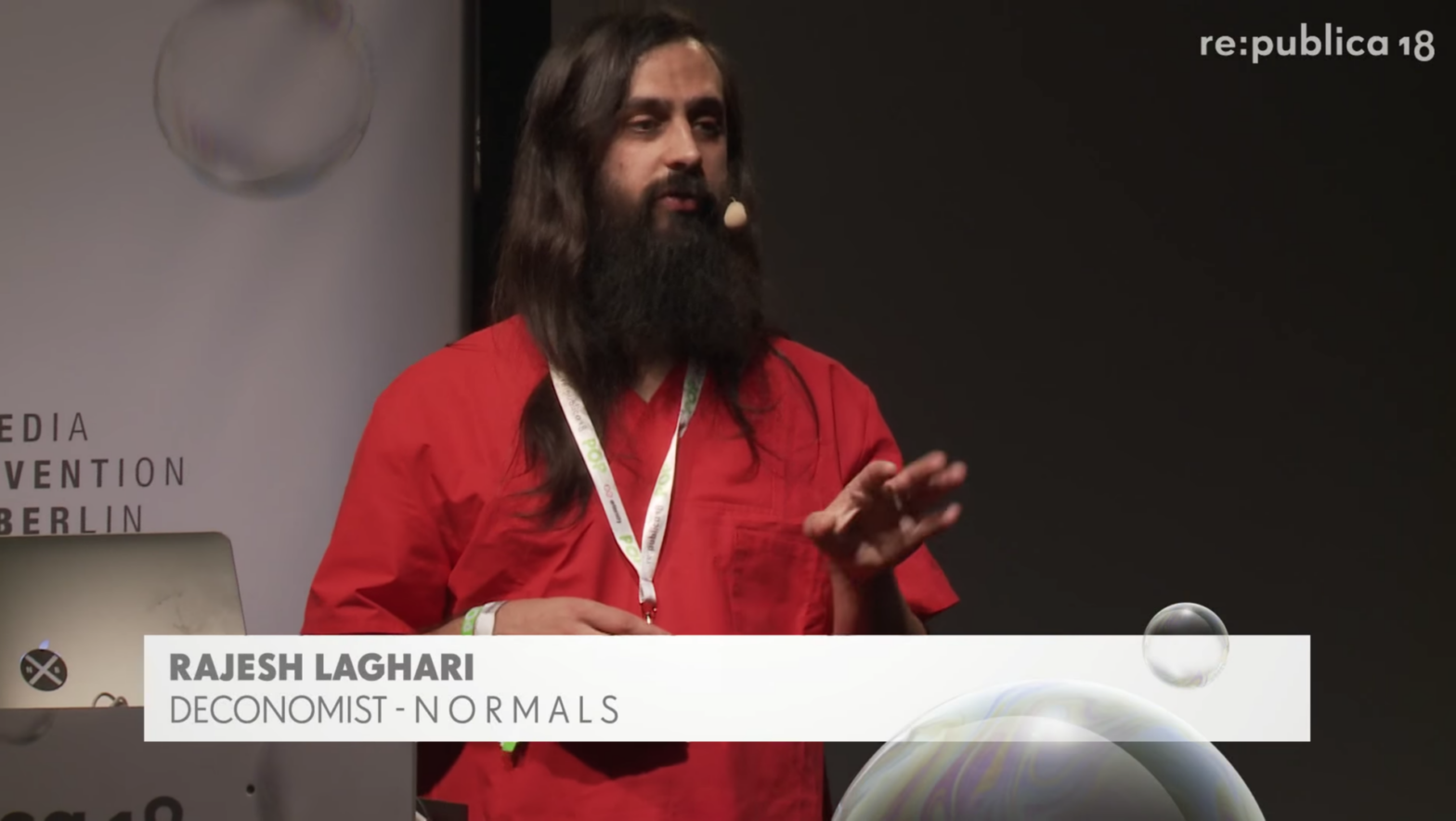When necessary decisions radically impact the lives of millions, some form of compensation is needed to support them during the transition. La Renta is a take on universal income that turns infrastructural lemons into economic lemonade.
La Renta is a subset of the CDRMX project, which proposed to relocate inhabitants of Mexico City away from the urbanised lakebed and onto newly-printed neighbourhoods on the hillsides surrounding the city. The goal of this operation, presented as ongoing, is to retrieve the essential ecological zone of former lake Texcoco. Multiple city officials, alongside local architect Alberto Kalach, claim doing so is the only way for the city to subsist into the future. It is also considered that hillside settlements might — rather counterintuitively — be less subject to the damages caused by seismic activity. At the request of the city council’s think tank LabCDMX, we decided to explore how relocating citizens could happen in the context of a densely populated metropole struggling with endemic unemployment and corruption.
When a New Home isn’t Enough
That the new neighbourhoods are of higher housing standards than the Colonias Populares, where many residents currently live, makes little doubt. The modern Impresos Populares are built using state-of-the-art habitat-printing technology, pairing seismic resilience with ingenuous ways to optimise resources usage and access to sunlight. But even provided free of charge might not suffice to convince residents of the Colonias to leave the houses they often built with their own hands, to instead move into areas where economic activity is uncertain. The question then made itself clear: how can one offer a fair incentive that alleviates doubts and makes the proposed alternative a clear improvement. Simply handing out money was not an option, as the risk of it landing in the wrong hands was simply too high. From this challenge, an answer quickly became evident: the CDRMX project should ensure every relocatee a guaranteed income that would allow them to cover their needs, and some wants. But that income should not just give people money to consume—it should also stimulate the Impresos’ economy. We would have to think a way to incentivise investing locally: la Renta was born. La Renta is a universal income with a twist: it is granted at the start of every month, and devalues itself in full at the end. This means any money not spent is lost to the user. As La Renta is designed to cover more than the basic needs, there should remain money at the end of the month. From this, different strategies exist to keep the benefits of that overhead: it can be saved, at a loss, or invested at a return.
A Currency For The Impresos: The Mexicoin
To avoid problems linked to distributing the income in Mexican Pesos, a new currency was created. The Mexicoin is a new cryptocurrency developed for local use only, and which can only be used for the purpose of distributing La Renta. It relies on the HashMesh: a custom technical infrastructure designed specifically to offer “fast, secure, fair, and low-cost transactions on networks of any scale.”
Fictional whitepapers
To avoid objection from the tech-savvy, we gave the Mexicoin its own technological framework and associated jargon. The fictional whitepapers describing the HashMesh were written as a way to support our claim. To provide enough theoretical background — even if made-up — that technicalities wouldn't be questioned. As such, the content only needs to be correct enough to be believable.
Doing so lets us focus on the project, rather than the underlying technology.
Mexicoins exist solely within what some may call a microsocialist system: its mining is centralised and capped, and it cannot be bought using other currencies—you can exchange Mexicoins for pesos or dollars, but not the other way around. The HashMesh is the infrastructure supporting Mexicoin, which is the currency supporting La Renta. While these two elements help proof the fiction and keep technical objections at bay, the uniqueness of this project lies in it acting as a self-sustaining ecosystem. Its primary goal is to ensure everyone gets their allocated income, and its secondary goal that the money benefits local economy.
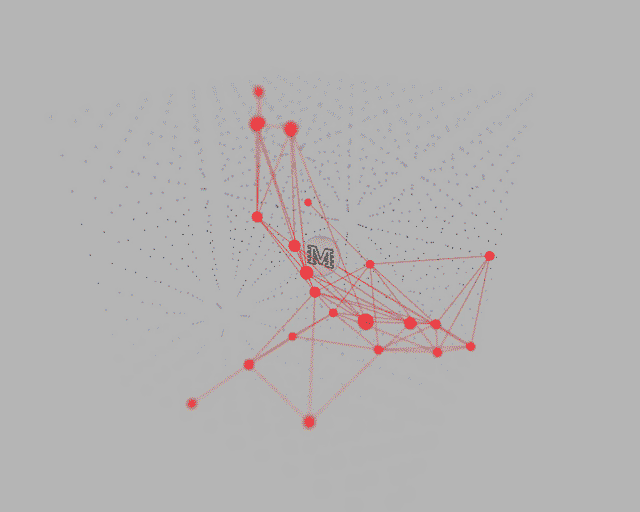
A Composite Economic System
To achieve this dual objective, the system brings four different accounts into play: the first two are private, equivalent to a current and a savings account; one is a type of investment portfolio keeping track of supported projects; the last is a collective account owned by the entire Impreso. They are called la Cuenta, los Ahorros, los Proyectos, and el Tarro.

1. La Cuenta
The first account is La Cuenta, on which La Renta is deposited at the start of each month. 1500 Mexicoins for adults, 1000 for children, no exceptions—within the proposed economic model, that’s more than enough to live comfortably. La Cuenta is the current account used for daily transactions, and is fully devaluing. That means that at the end of the month, every Cuenta goes back to zero before being refilled. Any overhead automatically goes to a second account called Ahorros.
2. Los Ahorros
Los Ahorros is a savings account which operates in two different ways based on the Mexicoin timestamp. It’s devaluing any coin deposited after March 1st of the current year by 20% each month, while keeping previous funds whole. For children, the missing 500 Mexicoins to their Renta are deposited on this same account with a special stamp that locks them until their 18th birthday. The reason behind this system is to discourage capitalising, so that most of the Mexicoins left untouched at the end of the month will be injected in a local, participative economy powered by Los Proyectos.
3. Los Proyectos
Los Proyectos are at the very core of the participative economy model. Think of it as an incentivised kickstarter, which allows residents to invest their spare Mexicoins in return for goods or services — never money — that will make their life cheaper, or more comfortable, or more fun. For instance, a small spender, whose main expense in terms of entertainment is going to the movies will probably invest in a local cinema project that, once funded, will grant them a free movie ticket each week. They will spend less on movie tickets, and have more money to invest elsewhere. This way we can fund quality schooling and retirement homes, local community gardens, sport and culture events, collective gifts, security services, etc… We are getting a little closer to the idea of distributed politics in the sense that most public projects are voted for through participative economy. It might sometimes happen that a project doesn’t get funded in the allocated timeframe, which shows it isn’t a priority for the district. In this case, the project is cancelled and all allocated funds are automatically redistributed to each contributor’s Ahorros, and will be devalued monthly until March. The Mexicoins lost in this process are collected on a collective account known as El Tarro.
4. El Tarro
El Tarro allows public services to cover functioning costs. We have estimated that 7.8% of all produced Mexicoins will fall back to public use through that system which, considering the lowered infrastructural costs of printed districts and the private injection of fund in local services, will keep all basic maintenance expenses covered, with some to spare. This also acts as a buffer that lets the machine keep inflation under control.
Case Studies: La Renta Eradicates Poverty, not Wealth
In order to illustrate the possibilities offered by La Renta, various cases were imagined and dissected. They correspond to different spending, saving, and investing behaviour, as well as ways to use allocated Mexicoins collectively—for instance as part of a family. These examples show that, while there exist ways to build wealth within this system, these go through different channels in ways that profit the community as a whole. It is also a much needed paradigm shift to consider that when the community benefits, so does the individual.
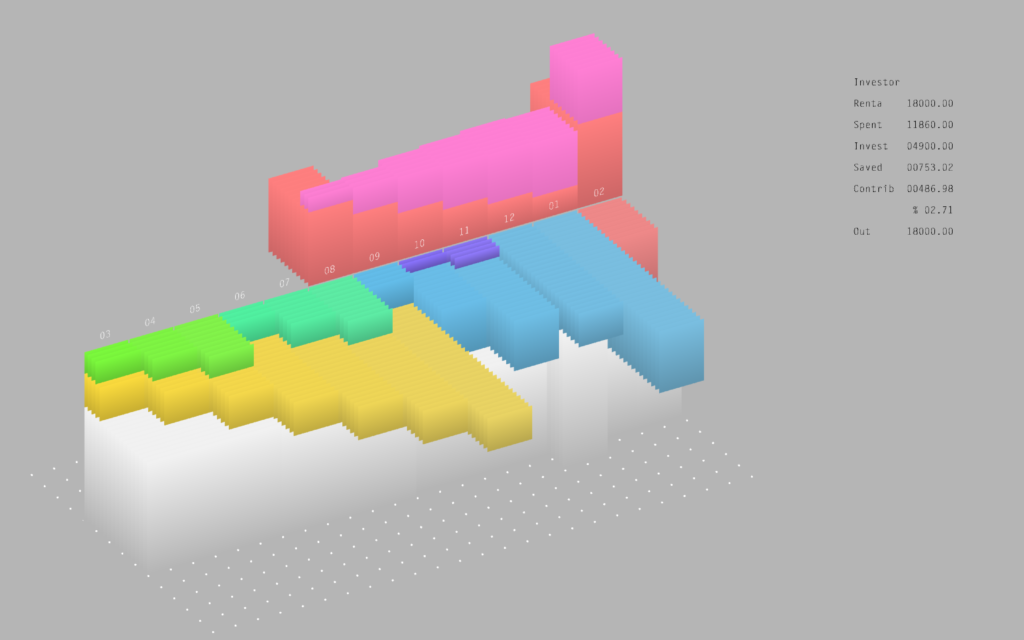
The Investor
The best way to take advantage in the system is to invest in projects. Consider someone who backs projects with good chances of success. Once funded, these projects give out perks — a weekly fruit basket or a monthly theatre ticket — which allow them to reduce spending, and to invest more. The occasional failure (here in August) leads to invested funds being transferred to Los Ahorros, and each month 20% of the remaining sum is lost to El Tarro. There is an understandable spike in spending during Christmas season, followed by a logical decision to save all in February, just before Los Ahorros are locked. By the end of the year, this investor has saved half a Renta, invested three, and contributed 2.7% of their income to the collectivity.
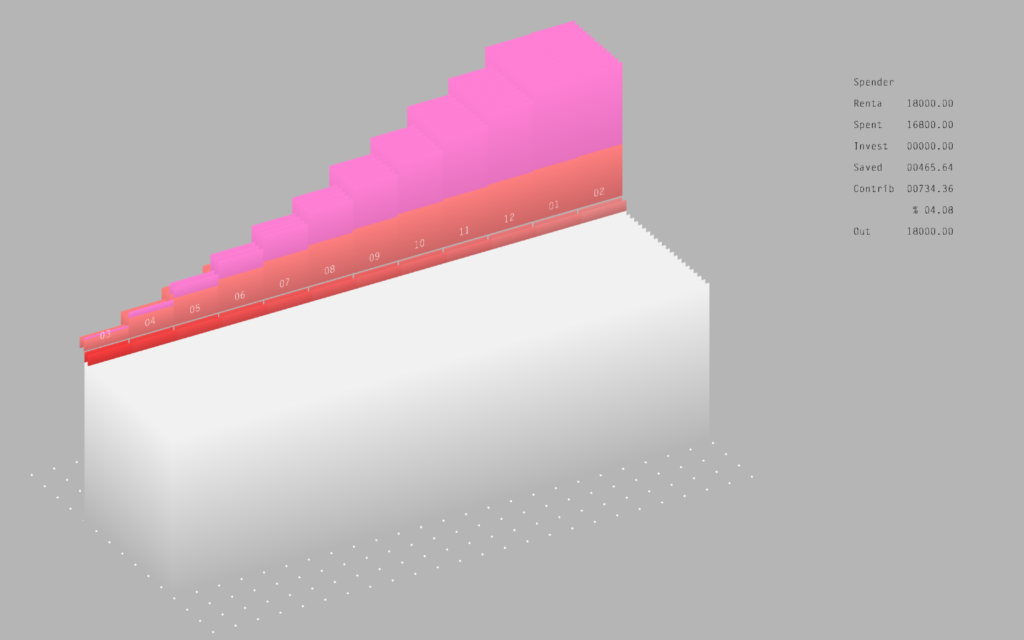
The Spender
On the other end of the spectrum, the spender is someone who lives a life of relative luxury, spending nearly all their Renta every month. Despite not doing any investing, this spender only lets 200 Mexicoins fall to Los Ahorros every month. Their savings top at one third of a Renta, while contributing around 4% to El Tarro. That strategy is not the most fruitful in terms of long-term planning, but the money is spent nevertheless.
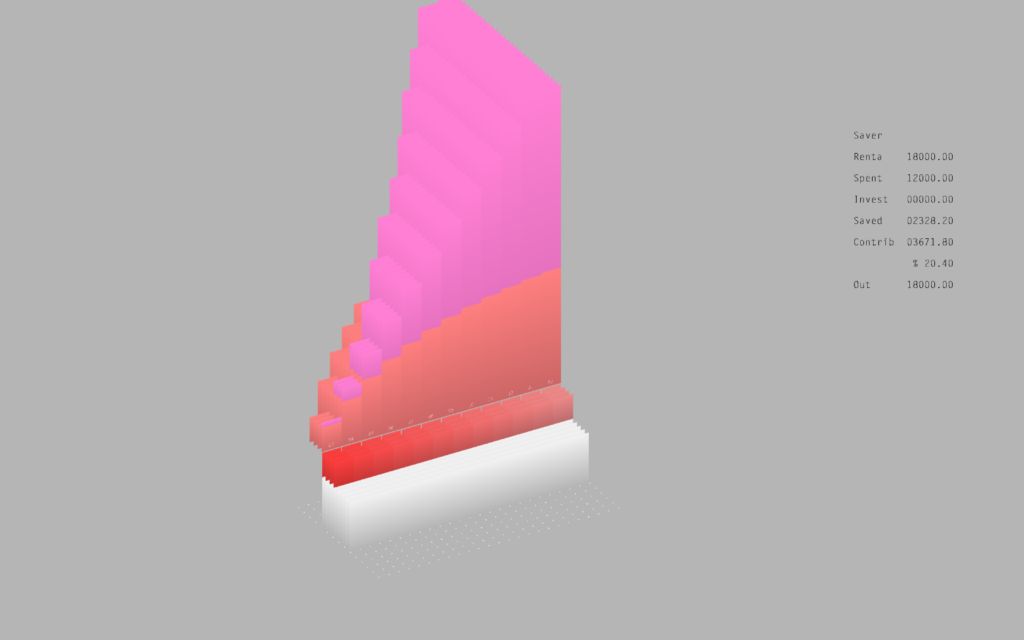
The Saver
The traditional method of saving, while possible, provides the least return due to the strong devaluation of Los Ahorros. Someone who aggressively saves a third of their Renta every month will end up having saved 2300 Mexicoins, and contributed 3600 to the collectivity—over 20% of their original income. In this system, pure capitalisation yields little.
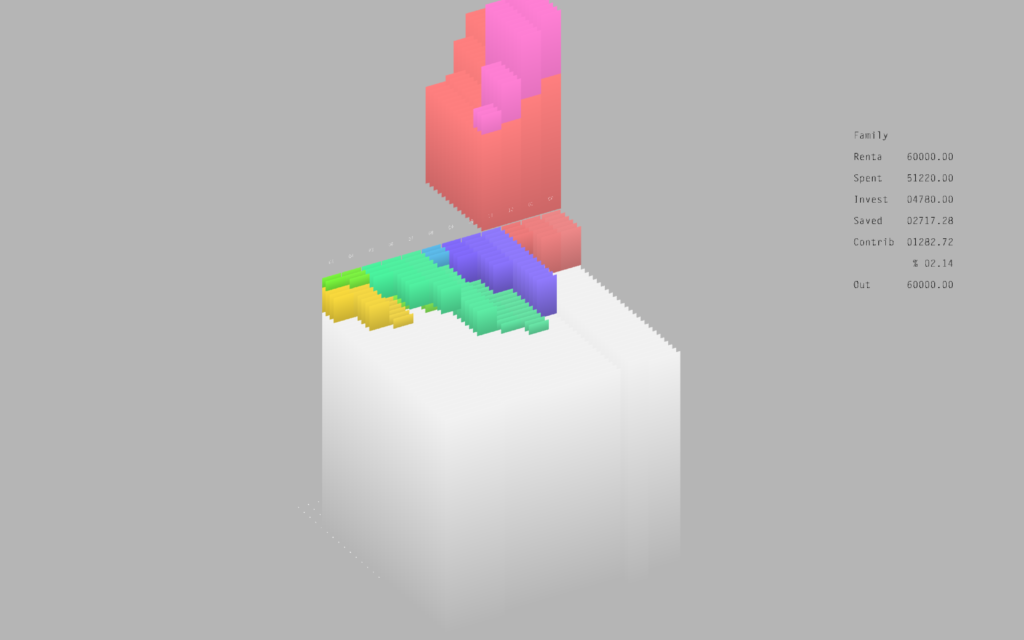
The Family
The last case is that of a couple with two children, who start the month with 5000 mexicoins — it’s of course possible to join accounts. They invest wisely in the community garden and a school fund, and only when they try to fund a restaurant does their investment collapse to Los Ahorros and they start paying taxes. Because it’s close to the end of the year, they change their strategy and do full-on saving after that, which allows them to push over half their combined monthly income into locked savings, while having contributed 2.14% to El Tarro.
Physical and Cultural Extensions
Because Mexicoin is a fully digital currency, there is no paper money or payment card. Instead, every citizen is given a phone-sized terminal letting them receive payments: the MexiWallet. A fingerprint scan and pin code is all one need to issue a payment, and since terminals are used to receive, not send funds, a lost or stolen MexiWallet is no big deal. Using it, one can also check one’s accounts balance, navigate proyectos, and communicate for free with other impresos residents using a local network.

Following the initial CDRMX presentation, several grassroots projects emerged that were directly influenced by La Renta. Among these, a political group campaigning for decisionless politics, proposing instead a central algorithm able to autonomously start Proyectos based on people’s best interests, as perceived through their daily routines or emotional states. Another was the Cryptoball, a new sport stemming from the practice of investing leftover Mexicoins into a physical Proyecto: a ball hidden somewhere on the Impreso on devaluation night, which spills out money at a steady rate to the account of whoever holds it, for as long as they hold it. In its later evolution into an official sport, the practice sees two teams compete in a vertical arena, attempting to hit a flyer as high as possible. The last person to launch it scores points until the opposing team gets a hit. Like many sports, professional Cryptoball doesn’t come free of shady operations—these were explored in an article titled I Went to Mexico City to Discover How Crypto-economics Could Save the Environment, and All I Got Was This Lousy T‑shirt, published a few years later as a collaboration between Goethe Institut Mexico, Centro de Futuros, and Pitzilein Books.
In 2018, La Renta had the occasion to take a life of its own. It was then pitched by Rajesh Laghari as part of a series of FinTech conferences at re:publica18 in Berlin. Following this event was an offer by (real) economist Joe Rini from IASS Potsdam to have a closer look at the proposed solution, which sparked interesting debate on possible ways to make use of such an approach, as well as possible improvements on the original idea.
